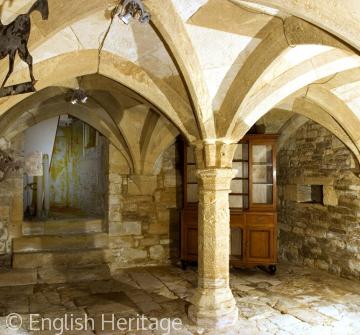High Street (east), No. 109 (London House)

This impressive late medieval house may have been owned in 1552 by the clothier Edmund Silvester: his descendants certainly owned it in the early 17th century, when it was let to the Jordan family. On stylistic grounds the house was built c.1480 for someone of high status. The exposed timber frame originally had rows of windows to each upper floor: two cusped lancet pairs remain at first-floor level, while peg-holes and shaped studs show where the second-floor windows were. At a time when glass was expensive this was a high-status statement. Blocked mortices mark the location of brackets which once supported some form of canopy at eaves level. Of similar date are the large vaulted undercroft, probably let as a tavern, the carved stone fireplace in the first-floor front room, and stone arched doorways giving access to the stairs. The dog-leg stairs themselves are (late) 17th-century.
Later occupants included the mercer Timothy Bevington (1787) and, throughout the 19th and early 20th century, a succession of drapers. The current shopfront dates from soon after 1900, around the time that W.H. Akerman (a ‘grocer and provision dealer’) replaced the draper Thomas Chandler. Later occupiers included furniture dealers during the First World War, a cycle agent in the 1930s, and from c.1980 Manfred Schotten Antiques, still there in 2007. The name ‘London House’ was used from around 1876.
See: M Wood, English Medieval House (1965), 268–9; RH Gretton, The Burford Records (1920), 401, 451, 475, 637; N Pevsner, Buildings of England: Oxfordshire (1974), 515
Content generated during research for the paperback book 'Burford: Buildings and People in a Cotswold Town' (ISBN 13 : 9781860774881) for the England's Past for Everyone series






